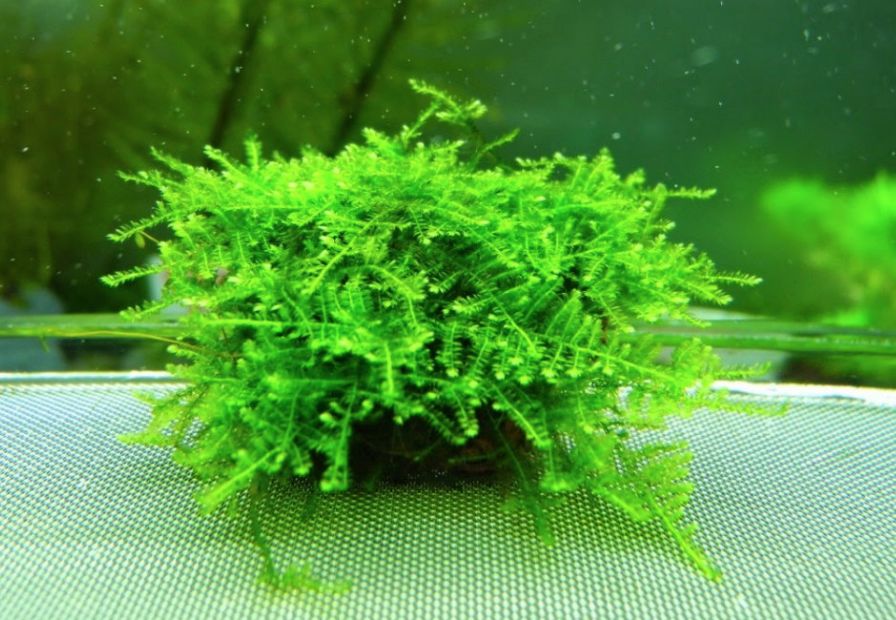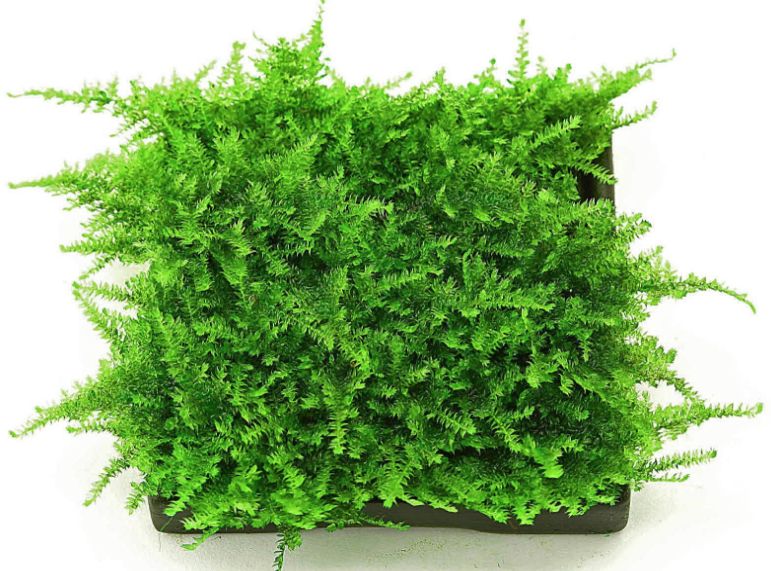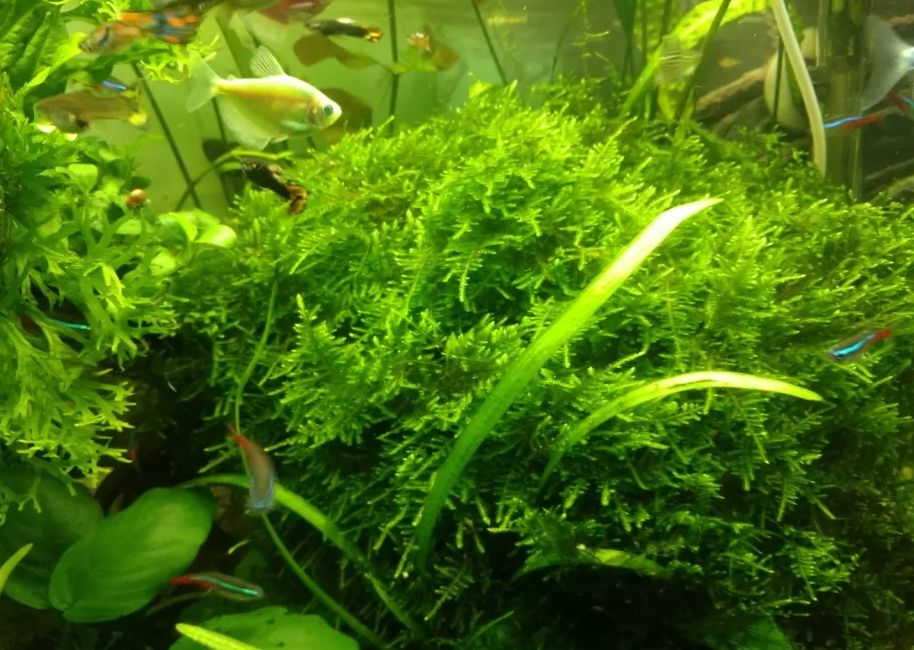Christmas moss (lat. Vesicularia montagnei) – is an aquarium plant which together with Java moss makes the most widespread mosses in aquarium husbandry. Christmas moss got its name due to the fact that its preformed shoots hang down and overlap each other like fir-tree branches and the moss itself resembles a fir-tree shape as well. However, green color of this moss is much brighter and lighter, than that of Java moss.
At the same time Christmas moss that grew provided with poor conditions (low illumination level, absence of CO2 and fertilizers, hard water, seldom water renews) is not that branchy and due to this it is very difficult to distinguish it from Java moss

Contents
Habitat in the wild
In the wild Christmas moss grows on humid and shadowed river and pond banks as well as in some forest areas with high humidity level. There are no exact borders of this kind of moss natural habitat, apparently they don’t exist; but more often you may encounter its original kind in waters of India. However, it also inhabits in China, Japan and some areas of South-East Asia.
The bush sticks to a substrate as well as to various objects: drowned tree boles, branches, snags and even stones. The Christmas moss prefers warm streaming water and grows successfully as a colony (a bush) only in a clean environment. In muddy water it just won’t survive and if the habitat suddenly gets polluted, it dies.
According to the scientific classification this representative of aquatic flora is from Bryida subclass, Hypnaceae family, Vesicularia kind. Latin name of the kind is Vesicularia montagnei, which means “crying moss” in Latin.


Difficulties in keeping
In general, Christmas like other aquarium mosses is not demanding. However, any abrupt change of water parameters, for example, variations of general water hardness during careless water renews may cause stress and growth rate of the moss will slow down.
The growth rate of Christmas moss (Vesicularia montagnei) can vary depending on the specific aquarium conditions and care provided. Generally, Christmas moss has a moderate growth rate compared to some other aquarium plants. Under ideal conditions with proper lighting, carbon dioxide supplementation (optional but beneficial), and nutrient-rich water, Christmas moss can exhibit noticeable growth within a few weeks to a couple of months.
| Aspect | Description |
|---|---|
| Scientific Name | Vesicularia montagnei |
| Common names | xmas moss |
| Appearance | Soft, bushy moss with triangular, slightly curved leaves resembling a Christmas tree |
| Growth Rate | Slow to moderate growth rate, suitable for low to high-tech setups |
| Light Requirements | Thrives under moderate to high lighting conditions |
| CO2 Requirement | Can grow well without CO2 supplementation, but benefits from CO2 injection for faster growth |
| Water Parameters | Temperature: 68-82°F (20-28°C); pH: 5.0-8.0; soft to moderately hard water |
| Attachment | Attaches to various surfaces like rocks, driftwood, and aquarium decorations |
| Maintenance Level | Low-maintenance plant; occasional trimming to maintain shape and prevent overgrowth |
| Propagation Methods | Easily propagated by cutting and reattaching sections of the moss |
| Versatility | Suitable for aquariums, terrariums, and paludariums; provides hiding spots for small aquatic species |
| Benefits | Enhances water quality by absorbing excess nutrients and provides shelter for fry and small fish |
| Common Uses | Aquascaping, creating a natural and festive appearance, attaching to hardscape for a unique look |
Description
Christmas moss features delicate, bright green fronds that branch out in a dense, feathery pattern. The moss forms compact, lush cushions or carpets when allowed to grow freely. It is a slow to moderate growing plant that can attach itself to various surfaces such as rocks, driftwood, and substrate. The branches of Christmas moss can extend up to several centimeters in length.
Christmas moss vs java moss
Quite often Christmas moss is mistaken for a widespread Java moss. Sure, at first glance they are very much alike.
But this is just the first impression you get. If you take a closer look, you will see the difference in the structure of its branches:
- Java moss has almost straight thallome (a vegetative shoot or moss branch) without any sprouts,
- Each shoot of Xmas moss has tiny sprouts that grow symmetrically from the branch stem.
Size of these shoots gets smaller towards the thallome top and this shape resembles a triangle or a fir-tree shape. This is where the moss name came from. When its branches grow to reach some certain length, they bend under their own weight like those of a weeping willow.
To be fair, we should mention that such a structure is peculiar not only to Vesicularia montagnei kind, however people started to call this moss a Xmas one only due to its wide occurrence in aquascaping. It seems that it’s just not the time yet for other similar mosses to be used to create decorative effect in tanks.
Keeping in a tank
Water parameters
Christmas moss is considered to be the easy one to keep. Really, it is completely undemanding and it can successfully grow at room temperature, it can vary from +18 to +26°C. Christmas moss thrives in a temperature range of 68-82°F (20-28°C). It can tolerate slightly cooler or warmer temperatures but may exhibit slower growth outside this range.
Water hardness and its pH doesn’t play any significant role here, but yet it’s better to stick to average values of these parameters in a tank. Ideally, maintain a slightly acidic to neutral pH level for Christmas moss, ranging from 6.0 to 7.5. It can tolerate slightly higher or lower pH levels, but extreme fluctuations should be avoided.
Christmas moss can adapt to a wide range of water hardness, from soft to moderately hard. It can tolerate a general hardness (GH) of 2-15 dGH and a carbonate hardness (KH) of 2-15 dKH.
However, you will have to constantly monitor the purity of tank water. Christmas moss can’t grow in muddy ditch water, that’s why it requires high-efficient purification system and creating some water flow.
As other similar plants moss accumulates organic remnants in its bushes, some microorganisms develop there as a result as well as various small spineless species and thread algae. If you don’t clean (siphonage) tank vegetation occasionally, it will undergo degradation in time.
Except this compulsive weekly ‘overall cleaning’ experienced aquarists also use some natural ways of preserving the Christmas moss in good condition. Cherry shrimps are very helpful in this respect.
If you keep them in your tank, they won’t just live in the bushes, they will also clean their ‘home’ from algae and other rubbish. Such a neighborhood makes quite mutually beneficial and natural co-operation after all.
Lighting
As for illumination, its power and intensity should be selected taking into account comfortable existence of other tank dwellers, since it’s not of crucial importance for the Christmas moss. It was noticed, that the moss becomes a bit more bushy at low illumination intensity. Christmas moss can thrive under moderate to high-intensity lighting conditions. Provide around 2-3 watts per gallon of fluorescent lighting or adjust the intensity accordingly with LED lighting.
Water flow
Christmas moss appreciates moderate water flow in the aquarium. Adequate water circulation helps distribute nutrients and prevent debris from settling on the moss, promoting healthier growth.
CO2
While Christmas moss can grow without CO2 supplementation, providing a consistent supply of carbon dioxide can enhance its growth and vibrancy. CO2 injection is optional but can be beneficial.
Nutrients
Christmas moss benefits from a nutrient-rich environment. Regularly fertilize the aquarium water with a balanced aquarium plant fertilizer that includes both macro and micronutrients. Ensure that nitrogen (N), phosphorus (P), potassium (K), and trace elements are adequately supplied.
Care
Maintain an aquascape composition you should cut from time to time. Otherwise, because of lack of light in the bottom layers they may start to rot and fall off a stone or a snag.
There are two ways you can cut:
- Cut the whole upper layer. After this the moss will grow many small and short brunches and they will make a fluffy hillock.
- Cut the moss brunches selectively and leave the most branchy shoots. After such a cut the moss will grow ‘hanging’ hillocks.
When cutting the Christmas moss especially using the 1st way, try remove the cropped brunches from the tank right after this; at the same time you can perform water renew and siphonage the rest of the bush.
Otherwise, the cut brunches will spread all over the tank and you will get the bushes growing where you didn’t plan to have them in your aquascape.
How to plant christmas moss in aquarium
To plant Christmas moss (Vesicularia montagnei) in an aquarium, begin by preparing the moss, either by separating a bunch or removing it from a rock or mesh pad. Next, select a planting surface such as rocks, driftwood, or the substrate. Clean the chosen surface if necessary.
Attach the moss to the surface using thin thread, fishing line, or non-toxic glue (Super Glue), ensuring it is secure but not too tight. Position the attached moss in the desired location within the aquarium, considering its growth pattern and aesthetic impact. Maintain optimal water parameters, lighting, and nutrient levels to promote its growth. Regularly trim and shape the moss to prevent overgrowth and remove any debris or dead portions. With suitable care, Christmas moss will thrive and add a lush, natural touch to your aquarium.
Sources:
- https://tropica.com/en/plants/plantdetails/Vesiculariamontagnei’Christmas'(003APOR)/4395
- https://dennerleplants.com/en/plants/plantdetails/Vesicularia-montagnei-(30065)/23047
- https://aquascape-promotion.com/christmas-moss-en
- https://www.researchgate.net/publication/369831488_Axenic_in_vitro_cultivation_and_genome_diploidization_of_the_moss_Vesicularia_montagnei_for_horticulture_utilization